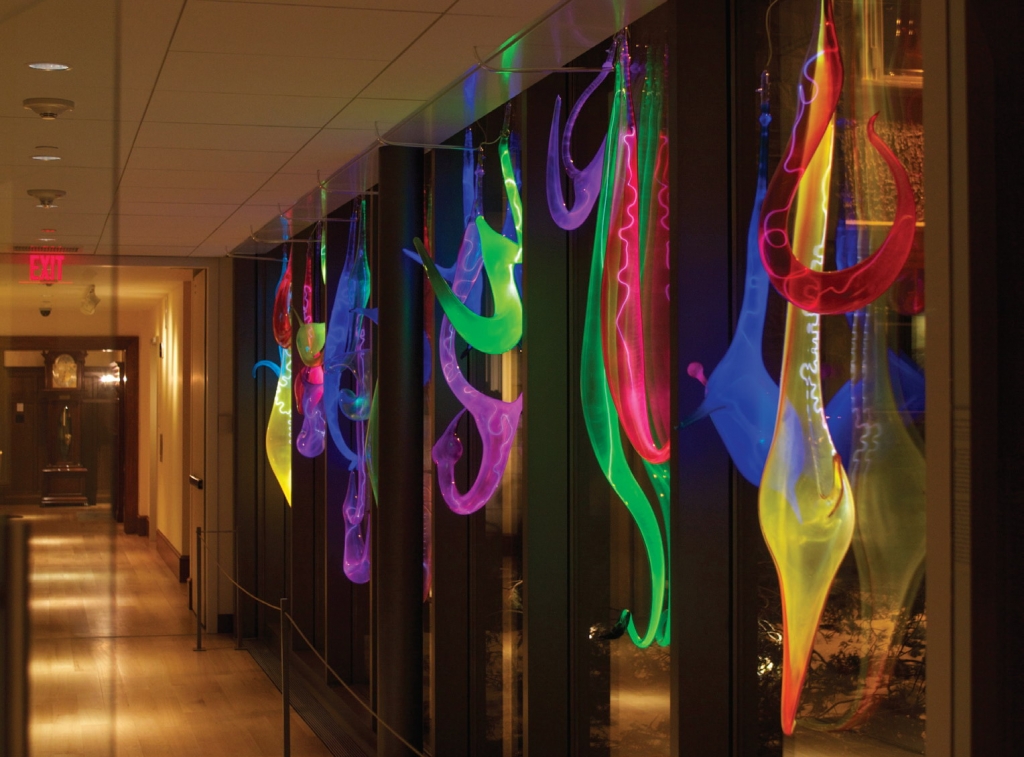Living or working in the shadow of a famous relative can impede establishing name recognition for yourself. However, the neon-sculpting talents of Mundy Hepburn, nephew of the late actress Katharine Hepburn, prove his family’s creative gifts don’t end with legendary performances in The African Queen or On Golden Pond.
“When I was little, she was just Aunt Katy,” he said. “It was only when I got older that I realized she was a movie goddess. Creativity ran in my family; my father was a playwright, and my mother designed fabric art.”
When Hepburn turned 14, his father bought him an arc welder. After some fits and starts learning to use it, he visited Paul Geyer, a glass artist whose work he’d admired at a fair as a youngster. Geyer sent him to Joey Buccelli, an old friend and tubebender. He learned how to bend neon tubing, and made his first sign for a neighboring shoe store. His interest in luminous-tube art intensified when he saw a plasma globe in a Sharper Image catalog. When he needed a high-voltage power supply, a friendly TV repairman sent him the innards of a broken set.
“Using the TV carcass, I blew a small bubble with my torch and put a single electrode in it. I hooked the wire from the TV to the bubble and welded it onto the neon-vacuum manifold, pumped it down and told my friend to touch it. I opened the argon valve all the way … and there it was, a tiny plasma arc, wiggling away. I was hooked.”
Today, Hepburn builds his own equipment, and formulates custom glass from sand and other fluxes. He begins his process by blowing basic glass shapes, and then manipulates the glass to create a 15mm tube in which he places the electrodes. Then, he anneals the glass in a large oven and assembles the electrode. After dusting on phosphor coatings, he puts the lamp into the giant oven and welds the tubulation into the manifold. Using old, rotary-vane pumps, he pumps noble gases into it. With a small torch, he tips off the tubulation. He uses a customer-made, inverter power supply, which, with the gas mixture, creates the plasma effect.
As his work has evolved and word has spread, he’s earned commissions for numerous museums, private homes and corporate environments. Two years ago, an architect (who’d seen Hepburn’s work two decades before as a Yale student) commissioned him to create a luminous-tube sculpture for a NYC building’s rooftop. It was a compelling combination of beauty and durability; Hepburn said Hurricane Sandy wrested only a single electrode from it.
“I’m very fortunate that I grew up in an environment where art was a way of life,” he said. “I may not have the wealth or fame my aunt accumulated, but I feel the same deep satisfaction as an artist when a client says, ‘Oh, I love it.’”



 Tip Sheet2 weeks ago
Tip Sheet2 weeks ago
 Photo Gallery3 days ago
Photo Gallery3 days ago
 Ask Signs of the Times5 days ago
Ask Signs of the Times5 days ago
 Real Deal2 weeks ago
Real Deal2 weeks ago
 Paula Fargo23 hours ago
Paula Fargo23 hours ago
 Benchmarks1 week ago
Benchmarks1 week ago
 Photo Gallery24 hours ago
Photo Gallery24 hours ago
 Women in Signs2 weeks ago
Women in Signs2 weeks ago









